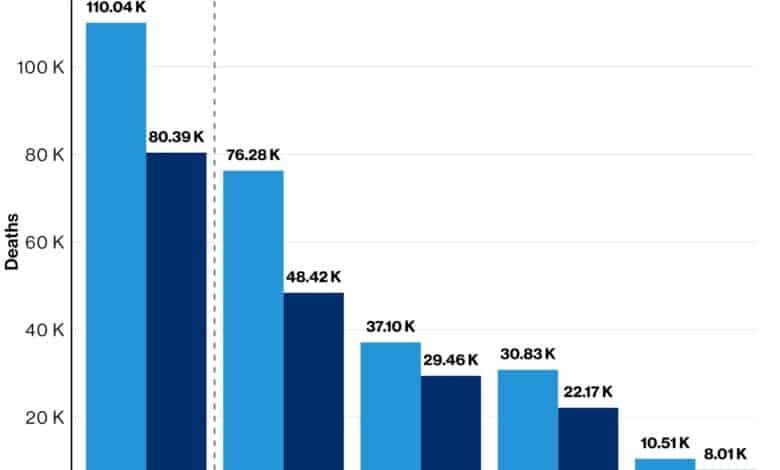Drug overdose deaths in the United States fell almost 27% last year, reaching the lowest levels since 2019: CDC

Drug overdose deaths fell in the United States last year to the lowest levels observed in five years, according to a new federal report published Wednesday morning.
The provisional report of the National Health Statistics Center of the Centers for Disease Control and Prevention found that drug overdose deaths throughout the country fell from 110,037 in 2023 to 80,391 in 2024.
This represents a 26.9% decrease and the lowest figure of annual drug overdose deaths since 2019, according to the report.
This is the second consecutive year in which drug overdose deaths have decreased after increases were observed year after year during Covid-19 pandemic, and researchers say they are cautiously optimistic about decreases.
“We should have an enthusiasm watched here because what we are seeing is almost the return to the overdose mortality rates that we had before the pandemic,” Dr. Petros Levoun, professor and president of the Department of Psychiatry and Decant Associate of the Faculty of Medicine of Rutgers New Jersey, who was not involved in the report, told ABC News.
“So essentially, we have corrected the blow and the increase in the overdose deaths we experience with the pandemic,” he added.

American drug overdose deaths
National Health Statistics Center
The report found that the greatest drop in deaths by type of drugs was observed in deaths related to synthetic opioids, including fentanyl, which fell from 76,282 to 48,422 between 2023 and 2024.
Decreases in overdose deaths due to psychostimulants, such as methamphetamine; cocaine; and natural or semi -synthetic drugs such as morphine.
In addition, almost all states throughout the country saw decreases in drug overdose deaths. Louisiana, Michigan, New Hampshire, Ohio, Virginia, West Virginia and Wisconsin, as well as Washington, DC, saw decreases of 35% or more than 2023 to 2024, according to the report.
In comparison, Dakota del Sur and Nevada saw each slight increases in 2024 compared to 2023, according to the report.
Lavounis, who is also the director of the Center for Excellence of Medicines for Rutgers addiction treatment, said that public health officials should also pay attention to Alaska, where opioid overdoses have constantly increased since at least 2018.
Overdose rates in Alaska have reached historical levels, according to CDC data, due to a Fentanyl proliferation
Fentanyl is up to 50 times more powerful than heroin and 100 times more powerful than morphine and can be mortal even in small doses, according to the Centers for Disease Control and Prevention. Other drugs can be mixed with mortal levels of fentanyl, and a user cannot see it, try it or smell it.
Experts told ABC News that they believe there are some reasons behind the fall in overdose deaths. One reason is the most widespread use of naloxone, the overdose reversion drug.
The United States Food and Medicines Administration approved Narcan for free sale in March 2023.
Narcan, manufactured by the emerging biosoluciones, occurs like a nasal sprays and naloxone, the active ingredient in the medication, can quickly restore the breathing of one if an individual is experiencing an opioid overdose, although its effect is temporary and some people may need additional doses.
Damage reduction groups and other experts have been pressing for easier access to naloxone as a strategy to help prevent some of the tens of thousands of overdose deaths that occur every year in the United States.

File photo of drug use.
Manusapon Kasosod/Getty Images
Dr. Allison Lin, a psychiatrist of addiction at the Faculty of Medicine of the University of Michigan, who did not participate in the report, said that there has also been a broader use of medicines to treat opioid use disorder, as well as an increase in public awareness of the dangers of opioid use.
“These are the things we know, at least from a research perspective, to save lives,” he told ABC News. “We have been fighting this epidemic of overdose for now more than a decade, so communities have invested huge efforts by the federal government, by our state governments, from prevention to overdose education.”
Lin said that although the data is encouraging, it is too early to say that the overdose crisis in the United States has ended and that public health officials should continue their efforts to reduce overdose mortality rates.
“It is good to celebrate all the hard work that people have been doing; we are starting to see some rewards of that,” he said. “But it’s not time for you to move to the gas pedal, I would say.”





